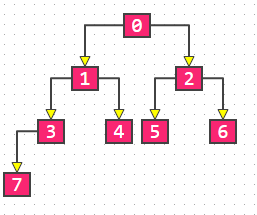首先毫无疑问,非递归的后续遍历必定要借助栈来实现,我们先用祖传的二叉树做个开头

根据页面提示,我们知道它的后序遍历结果为
7 -> 3 -> 4 -> 1 -> 5 -> 6 -> 2 -> 0

点击此处可以访问这个在线生成二叉树的页面
现在用Java实现代码,我们对节点Node及相关操作定义如下:
class Node{
int data;
Node left_child,right_child;
Node parent;
public Node(int data) {
this.data = data;
}
public void visit(){
System.out.print(String.format("%d -> ",data));
}
public void setLeft_child(Node left_child) {
this.left_child = left_child;
left_child.parent = this;
}
public Node setLeft_child(int left_child) {
this.left_child = new Node(left_child);
this.left_child.parent = this;
return this.left_child;
}
public void setRight_child(Node right_child) {
this.right_child = right_child;
right_child.parent = this;
}
public Node setRight_child(int right_child) {
this.right_child = new Node(right_child);
this.right_child.parent = this;
return this.right_child;
}
public Node getLeft_child() {
return left_child;
}
public Node getRight_child() {
return right_child;
}
public void postOrder_r(){
if(this.getLeft_child()!=null) {
this.getLeft_child().postOrder_r();
}
if(this.getRight_child()!=null) {
this.getRight_child().postOrder_r();
}
this.visit();
}
public void postOrder(){}
}
其中postOrder_r是常用的递归后序遍历,很容易验证其正确性;postOrder是非递归实现的,目前为空
我们编写了如下的测试代码,如果两行输出内容一样就能证明算法是正确的
public static void main(String[] args) {
Node root = new Node(0);
root.setLeft_child(1).setLeft_child(3).setLeft_child(7);
root.getLeft_child().setRight_child(4);
root.setRight_child(2).setRight_child(6);
root.getRight_child().setLeft_child(5);
root.postOrder_r();
System.out.println();
root.postOrder();
}
下面要设法实现非递归后序遍历
如何实现?
首先考虑只有三个节点的情况:

后序遍历的结果必然是 左右根 也就是 1->2->0
因此,在一般情况下当我们处理一个给定的节点的时候,要按照相反的顺序将其自身、右、左子树入栈(栈顶为左子树),这样才能保证左子树早于右子树,右子树早于自身的出栈顺序。将自身入栈的操作只需要进行一次,而将左右子树入栈的代码则处在循环中,因为自身入栈可以认为是一种初始化操作
Stack<Node> stack = new Stack<>();
stack.push(this);
while(true){
Node top = stack.peek();
if(top.right_child != null){
stack.push(top.right_child);
}
if(top.left_child!=null){
stack.push(top.left_child);
}
}
目前,代码将在正确将所有节点入栈后陷入死循环。
下面观察一下出栈节点需要满足的条件:
第一个出栈的节点为 7 ,首先它是整个子树里最靠左的节点(简称极左节点),其次,它还是个叶子节点,所以我们很自然的想到如果我们栈顶出现了一个叶子节点,应该将其出栈并访问,也就是:
if(top.left_child==null&&top.right_child==null){
stack.pop().visit();
}else{...}
可是这样又会导致另一个问题,当7出栈,3到达栈顶的时候,程序会转而执行else的部分,而不是将3出栈,这样就会把7再次请进来从而造成死循环。
所幸,这样的死循环只是出现在父子节点之间,因此我们增加一个prev表示最后一个出栈的节点,判断当前栈顶节点是不是最后出栈的节点的父节点,如果是则继续执行出栈逻辑,如果为否才入栈子节点。
为了省去判空逻辑,我们可以将prev初始化为 this。
到此我们也清楚循环的终止条件了,栈空。
Node top = stack.peek();
Node prev = this;
while(!stack.isEmpty()){
if((top.left_child==null&&top.right_child==null) ||(prev.parent==top)){
prev = stack.pop();
prev.visit();
}else{...}
}
总结整个代码的逻辑,只考虑入栈部分,就是 将根节点 的 自身、右子树、左子树 入栈,非根节点则将其 右子树、左子树 入栈;考虑出栈时,当栈顶为叶子节点时将其出栈,同时记录这个节点,如果栈顶为非叶子节点,则检查栈顶节点是不是记录的节点的父节点,如果是则出栈,不是则将其 右子树、左子树 入栈,直到栈空为止。
import java.util.Stack;
class Node{
int data;
Node left_child,right_child;
Node parent;
public Node(int data) {
this.data = data;
}
public void visit(){
System.out.print(String.format("%d -> ",data));
}
public void setLeft_child(Node left_child) {
this.left_child = left_child;
left_child.parent = this;
}
public Node setLeft_child(int left_child) {
this.left_child = new Node(left_child);
this.left_child.parent = this;
return this.left_child;
}
public void setRight_child(Node right_child) {
this.right_child = right_child;
right_child.parent = this;
}
public Node setRight_child(int right_child) {
this.right_child = new Node(right_child);
this.right_child.parent = this;
return this.right_child;
}
public Node getLeft_child() {
return left_child;
}
public Node getRight_child() {
return right_child;
}
public void postOrder_r(){
if(this.getLeft_child()!=null) {
this.getLeft_child().postOrder_r();
}
if(this.getRight_child()!=null) {
this.getRight_child().postOrder_r();
}
this.visit();
}
public void postOrder(){
Stack<Node> stack = new Stack<>();
stack.push(this);
Node prev = this;




